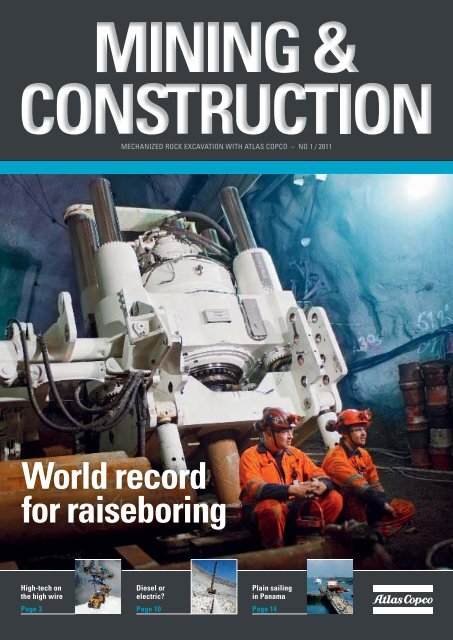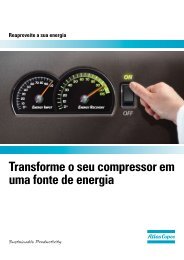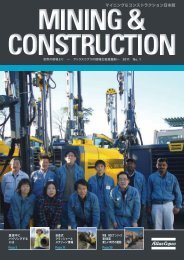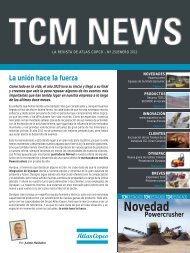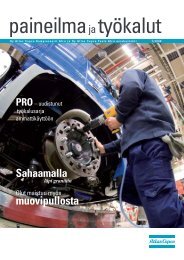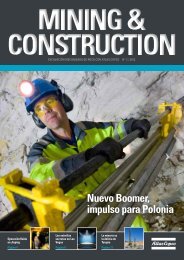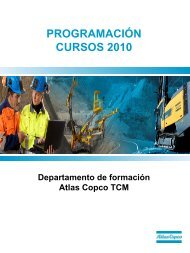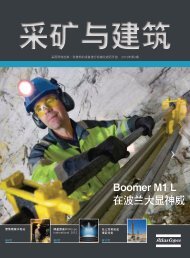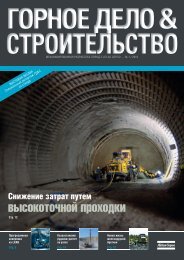World record for raiseboring - Atlas Copco
World record for raiseboring - Atlas Copco
World record for raiseboring - Atlas Copco
- No tags were found...
Create successful ePaper yourself
Turn your PDF publications into a flip-book with our unique Google optimized e-Paper software.
The <strong>Atlas</strong> <strong>Copco</strong> Robbins 91RH C raiseborer at Kiruna Mine: A highly advanced machine providing extreme powerand torque, pictured here with operators Ulf Lindström and Johan Garp of BergteamRAISING THESwedish Iron ore giant LKAB is building a new main level at its famous Kiruna Minein Sweden – and setting the scene <strong>for</strong> a world <strong>record</strong> in <strong>raiseboring</strong> technology.For the past 10 years, Sweden’s KirunaMine – the world’s largest undergroundiron ore operation – has been workedfrom a depth of 1 045 m, supplying highgrade pellets to the world’s steel mills.Now a new chapter in the mine’s rich historyhas just begun with a project to build acompletely new haulage level 320 m lowerdown. This will extend the life of the mineby another 20 years beyond 2030.Construction of the new 1 365 m level isa complex task exploiting all of the modernmining techniques you would expect onsuch a major development. But above all, itwill showcase the technology required <strong>for</strong>developing shafts and ore passes by hostingthe biggest <strong>raiseboring</strong> project of all time.The new infrastructure requires the constructionof a minimum of 55 000 m ofshafts and ore passes – 40 000 m at KirunaMine and a further 15 000 at the nearbyMalmberget Mine – all by 2014.Bergteamet, which is one of Sweden’sleading providers of mining and undergroundservices, is in charge of this part ofthe development work and is using Robbins<strong>raiseboring</strong> machines from <strong>Atlas</strong> <strong>Copco</strong>.Uniquely powerfulAs M&C went to press, two <strong>Atlas</strong> <strong>Copco</strong><strong>raiseboring</strong> machines were on site, Robbins73RM-DC and the larger 91RH C, whilethree more Robbins 91RH C machines wereon order. All of the units are tasked with bor-6 MINING & CONSTRUCTION – 1 / 2011
A prime example of fine <strong>raiseboring</strong> technology: Perfectly straight and smooth walls,bored at precisely the required diameter.STAKESSwedishiron minersstage world’s biggestraise boring projecting raises ranging from 90–360 m long andup to 5 m in diameter.Weighing in at 33 tonnes, the Robbins91RH C is an enormously powerful machine.It has a pulling power of 6 800 kN and a continuoustorque of 450 kNm.The rock consists of several different<strong>for</strong>mations including granite with a com-pressive strength of 220–350 MPa as wellas quartz porphyry with a strength ofup to 350 MPa.During upward reaming, the machineis also assisted in these hard rock condi-tions by the superior cutting capability ofthe Secoroc Magnum V cutters that aremounted in the cutterhead. Designed andmanufactured by <strong>Atlas</strong> <strong>Copco</strong> Secoroc inTexas, USA, they are designed <strong>for</strong> maxi-mum cutting efficiency in collaborationwith these <strong>raiseboring</strong> rigs’ massive rota-tion and feed <strong>for</strong>ces.Groups of fourAlthough the Robbins 91RHC is capableof boring raises up to 1 000 m long, theyare being used here to bore a large numberof short ore passes in groups of four.These will be installed between the differentlevels, ultimately linking up the new levelat 1 365 m.Net penetration when boring pilot holesis 0.95 m per hour and each machine isaveraging 10 m per day, depending on therock <strong>for</strong>mation and shaft length. Each raisewill take several months to complete.Bergteamet’s Project Manager at theKiruna site is Håkan Johansson, one ofthe <strong>raiseboring</strong> specialists who last yearassisted in the dramatic rescue of thetrapped Chilean miners and where raise-boring was one of the methods used toreach them.MINING & CONSTRUCTION – 1 / 2011 7
Rich history: The Kiruna Mine, located above the Arctic Circle inSweden’s far north, is going deeper with <strong>raiseboring</strong> technologyplaying a major role.Valuable assets: The quality of the drill pipes is decisive <strong>for</strong>productivity and have to be handled with great care.The <strong>Atlas</strong> <strong>Copco</strong> machines are ideal<strong>for</strong> this job because of the power andcontrol they give us.Håkan Johansson, Project Manager, BergteametIn Bergteamet’s service workshop at the500 m level, all of the 1.5 m long drill pipesare quality checked <strong>for</strong> possible cracksbe<strong>for</strong>e use. These are no ordinary drill pipes.Destination Kiruna:A brand newRobbins 91RH Cfresh off theassembly line,in the <strong>Atlas</strong> <strong>Copco</strong>yellow and gray.They are machined in one piece to exactlythe right shape and are made of high tensilesteel in an exclusive process, enabling themto withstand extraordinary loads. There<strong>for</strong>ethe pipes have to be handled with the greatestof care.During M&C’s visit, a new raise hadrecently been completed and its perfectlysmooth and straight walls clearly showedhow far <strong>raiseboring</strong> technology has comein recent years.All miners will no doubt be keeping awatchful eye on Kiruna Mine as the expan-sion project progresses. But it is by nomeans the only Swedish mine to launch amajor expansion as the current strongdemand <strong>for</strong> minerals and metals continuesto increase. The Garpenberg mine in centralSweden, is also undergoing a similar transi-tion, and here too, Bergteamet is installingshafts and ore passes using <strong>Atlas</strong> <strong>Copco</strong>’sRobbins 91RH C <strong>raiseboring</strong> rigs.NEW CHAPTERFOR KIRUNA’S IRONIron ore has been mined in Kiruna <strong>for</strong> morethan 100 years and today the mines in thisregion claim to be the most modern undergroundiron ore operations in the world.The Kiruna Mine consists of a single, continuousorebody almost 4 km long, 80 m thickand 2 km deep. More than 950 Mt of ore hasbeen mined from this site over the yearsyet only one third of the orebody has beenextracted. In 2010, LKAB produced more than26 Mt of iron products.The new main level is now being constructedat a depth of 1 365 m – the seventh time thelevel has been lowered since 1957.Based on annual production of about19 Mt of finished products, the operating lifeof the mine is expected to be extended bymore than 20 years.The expansion project is estimated to costsome EUR 1.2 billion and the first sections ofthe new main level are planned to be operationalby 2013.MINING & CONSTRUCTION – 1 / 2011 9
A simple choice <strong>for</strong>US copper mine gets topresults combining dieseland electric powered drills
The best of both worlds: Depending on the operation, the mobility and versatility of thediesel powered Pit Viper 271 has the advantage, but the electric version is also a goodchoice, especially when fuel costs rise.When it came time to replace its fleet of drill rigs, Asarco’s Mission Complex Minedecided to invest in two different power sources. The choice it made resulted ina winning combination.Mission Complex, located some30 km south of Tucson, Arizona,is one of the largest miningoperations in the USA. Operated by AsarcoInc., a subsidiary of Mexican mining groupGrupo Mexico, it has an annual productionin the region of 50 million tonnes and anore-to-waste cut off of .25 percent copper.When selecting drill rigs to replace itsaging fleet, Asarco looked <strong>for</strong> those thatcould provide cost-effective, high productionmanagement of the mine’s 11 m (36 ft)high benches with an additional 2.1 m (7 ft)of sub-drill.Mission’s bench patterns vary by <strong>for</strong>mation,from limestone to wollastonite withmany variations in between. In softer rock,a 9 m x 10.6 m (30 x 35 ft) pattern is usedand reduced to 5.5 m x 6.7 m (18 x 22 ft) inthe harder <strong>for</strong>mations.In the past, this presented problems withpipe, due to the abrasiveness of the rock.To meet the demanding conditions of amine of this size and of rock this hard ontools, the mine combined the features ofdiesel and electric rigs. They focused ontwo <strong>Atlas</strong> <strong>Copco</strong> Pit Viper blasthole drillmodels, ultimately choosing the single-passcapability of the PV-271 over the PV-351.They are now running two PV-271 drills– a diesel model just under three years oldand an electric model which went into servicein December 2009. The diesel modelwas purchased to extend the drill reach fromthe existing power capacity and to add versatilityto the drill fleet.At the time, the mine was operatingvintage electric-powered rigs and onefairly new diesel-powered DMM2 in threepits. Adding a diesel-powered PV-271met the bench and drilling requirementsin a single-pass drill rig that also offeredversatility and could be moved anywherein any of the pits.To make the holes, the PV-271 is usedwith two 7.6 m (25 ft) and one 2.4 m (8 ft)section of <strong>Atlas</strong> <strong>Copco</strong> 219 mm (8 5 /8") Teamalloypipe. Below that, they use a 1 m 41")stabilizer above a Secoroc air-bearing 270mm (10 5 /8") tricone bit.Diesel versus electricAside from the fact that one of the drillshas a power cable, they operate identically,11
<strong>Atlas</strong> <strong>Copco</strong>TEAMALLOY TM pipes at Mission Complex: The PV-271 drill runs with two, 7.6 m (25 ft) sections andone 2.4 m (8-ft ) section, 219 mm (18 5 /8") in diameter. Right, the Mission crew sets up the power supply <strong>for</strong> theelectric-powered version of the PV-271 which is used when time allows.says Mission driller Juan Salido. The electricdrill came with a larger compressor–74 m 3 /min (2 600 cfm) – whereas the dieselPit Viper has a 54 m 3 /min (1 900 cfm)compressor. Both average 8 000–10 000 mper month.Mine Manager Hal Galbraith says thediesel PV-271 works great <strong>for</strong> his mine.“I wouldn’t say we ran the tracks off therig, because we did haul it on our lowboytoo, but it went everywhere in the mine,”he says. Since then, the mine has focusedoperations to just two of the pits, but thediesel Pit Viper still moves to wherever it isneeded within the mining complex.Drill and blast manager Larry Maddoxnotes that the diesel rig offers a significantadvantage, working well at moving intotight spots on the bench to allow drillingto continue be<strong>for</strong>e power is moved into theworking area <strong>for</strong> the shovels.“Moving an electric drill just takes moretime compared to a diesel rig: having thecable crew available, cutting the power,moving the cable, planning the cable drops.You just can’t put a value on the mobilityyou get from a diesel drill,” he says.Salido adds: “It may only take 20 minutesto move the cable but 40 minutes or more<strong>for</strong> the crew to get there.”Anything that slows down a cable-movingcrew stops operations. For example, ifthe cable needs to be moved <strong>for</strong> an afternoonblast and the crew get a flat tire on thecable truck, everything would be held upuntil the tire could be changed.The diesel rig maximizes time spentdrilling. Softer rock at the mine may takeonly 20 to 30 minutes to drill each hole.However, other <strong>for</strong>mations that containmore garnet-tectite and wollastonite, mayrequire as much as two hours <strong>for</strong> the samehole requirements.Maddox says: “I think if you had plentyof time, electric would be better becauseof the cost to operate and maintain, butmobility more than makes up <strong>for</strong> it withthe diesel drill.”Comparing costsOne exception to this preference <strong>for</strong> diesel isthe operating cost. The electric drill currentlyoperates at 61 percent of the energy costs ofthe diesel drill and when diesel fuel edgedup to USD 4 per gallon (approx USD 1 perliter), the electric rig was more attractive.Galbraith lists some of the additional,indirect costs to be factored in with regardto an electric drill. Each electric rig requiresfour, 1 200 mm (4 000 ft) cables at USD100 000 each. A 138 kV–4160 V substationto power the drill costs USD 250 000.Additional manpower required to build theinfrastructure and to move the cable duringeach relocation must also be considered.Efficient drilling operations at Missionare the result of strategically matchingpipe and bits to these PV-271 rigs. TheTeamalloy pipe has a much higher costper piece price than other pipe, but itsdurability and longevity mean cost permeter is less in the long run.A 7.6 m (25 ft) section of Teamalloy pipelasts six weeks at Mission. Initial outsidedimension of the pipe is 220 mm (8.65").They will run it down to 203–200 mm (8 or7.9") be<strong>for</strong>e replacing it. The pipe shows itswear at the lower end of the joint, in whatoperators refer to as a “penciling” effect.They rotate these sections, since sectionscloser to the bit wear faster. This distributeswear evenly among the sections to increaselongevity overall.As <strong>for</strong> bits, the air-bearing type works thebest in this <strong>for</strong>mation with an average life <strong>for</strong>a bit at 2 300–2 440 m (7 500–8 000 ft). Eachdrill uses about two bits per week, dependingon the ground.Simple choiceFor Larry Maddox the choice is simple.“I want to keep them both,” he says.“Electric may be cheaper, but the mobilitywith diesel is better,” adding that eachhas characteristics that make the operationmore efficient and productive which, <strong>for</strong> thecompany, means greater profitability.Galbraith said the decision to buy this equipment<strong>for</strong> the drill and blast process is justifiedby the bottom line. He concludes: “For everydollar more you spend up front on drilling,you’ll make ten dollars on the back end.”12 MINING & CONSTRUCTION – 1 / 2011
Electric may be cheaper,but the mobility you getwith diesel is better.Larry Maddox, Drill and Blast Manager, Mission Complex.
AT THE PANAMA CANALThe Panama Canal is currently being expanded in order to double its capacity andboost its revenues from international shipping. Paving the way <strong>for</strong> the containerships of tomorrow is a fleet of a different kind.CaribbeanSeaGatun LakePANAMALimon BayGatun LocksUSAPedro MiguelMiraflores LocksPANAMAPANAMA CITYPacificOceanLocation of the Panama Canal: A popularshort cut <strong>for</strong> merchant ships sailing betweenthe Caribbean and Pacific oceans.The Panama Canal is one of the world’smost important international tradingroutes. Opened in 1914, it now enablesmore than 14 000 ships per year to travel backand <strong>for</strong>th between the Pacific and Atlanticoceans.But now, almost 100 years since thecanal was built, the Panamanian authoritiesare preparing to receive bigger, heaviervessels than ever be<strong>for</strong>e.It is predicted that the world will see amajor upswing in seagoing cargo trafficover the next few years, and to meet thischallenge the Panama Canal is racing todouble its capacity.Two new giant lock facilities are underconstruction – one at the Pacific end andone at the Caribbean end – to accommodatebigger ships, and carrying out thenecessary drilling and blasting work is afleet of six <strong>Atlas</strong> <strong>Copco</strong> drill rigs.This fleet, made up of ROC D7 drillrigs is owned and operated by Jan De Nulof Belgium, one of four companies withinGrupo Unidos Por El Canal (GUPC) incooperation with Sacyr of Spain, Impregiloof Italy and Cusa of Panama.Dual purpose drillingEquipped with COP 1840 hydraulic tophammerrock drills, 89 mm drop centerSecoroc bits and folding booms, these rigsare used <strong>for</strong> drilling and blasting at theso-called Third Lock Segment at the Pacificend of the canal.14 MINING & CONSTRUCTION – 1 / 2011
The rock here is broken and abrasivebasalt and nine million tonnes is expectedto be removed. In addition to preparing thesite, the drill rigs serve the dual purpose ofproviding aggregate <strong>for</strong> the construction ofthe lock at the Caribbean end where rockis scarce. This aggregate, which will bebarged up the canal, will be used <strong>for</strong> makingconcrete.Perfect accuracyThe ROC D7 rigs are working two, 10-hourshifts per day, drilling to a depth of 9.5 m onthree benches. About 2 000 m is drilled <strong>for</strong>each blast.To ensure accuracy, each rig is equippedwith the <strong>Atlas</strong> <strong>Copco</strong> hole quality systemHQS MKI2 which provides a widerange of practical features <strong>for</strong> hole qualityoptimization. These include hole depthPieterjan Versteele of Jan De Nul: “Theservice and support we get from <strong>Atlas</strong> <strong>Copco</strong>is extremely important on this type of job.”measurement, feed angle optimization andan alignment device with a laser receiverwhich enables the operator to position therig by lining it up with a distant referencepoint.Each rig is also equipped with <strong>Atlas</strong><strong>Copco</strong>’s Procom satellite monitoring systemwhich provides real time in<strong>for</strong>mationon hammer percussion, engine hours,maintenance schedules and rig location.The rock is a challenge but the rigs’arsenal of modern technical aids is helpingthe operation to progress smoothly. CommentsPieterjan Versteele, Jan De Nul’sPlant Equipment Manager: “After youremove the overburden, there are slopesand angles in the rock surface and the drillinghas to be perfect. You just can’t correctit afterwards.”First timersIt is the first time that contractor Jan DeNul has used an <strong>Atlas</strong> <strong>Copco</strong> drilling fleetand full support is provided by the recentlyopened <strong>Atlas</strong> <strong>Copco</strong> Customer Center inPanama. This support includes both ROCCare and COP Care preventive maintenanceservice agreements.MINING & CONSTRUCTION – 1 / 2011 15
The fleet on land: Some of the <strong>Atlas</strong> <strong>Copco</strong> ROC D7crawlers drilling at the Third Lock Segment at thePacific end of the Panama Canal.Hugo Arce, <strong>Atlas</strong> <strong>Copco</strong>’s BusinessDevelopment Manager <strong>for</strong> Central Americaand the Caribbean, says: “Maintaining qualitytooling, parts, and experienced techniciansare all very important <strong>for</strong> a contractorlike Jan De Nul and a project with the sizeand scope of the Panama Canal expansion.“There are fifteen operators on the site,and all of them have been trained by <strong>Atlas</strong><strong>Copco</strong>. They are very happy with the HQSMKI2 system and have been very quick tolearn it and apply it in their everyday work.”Versteele adds: “The just-in-time supportand service provided by <strong>Atlas</strong> <strong>Copco</strong>is extremely important <strong>for</strong> us on this typeof job. We are very happy with the productivity.Although we are seeing variable lifeon the bits as there are so many variationsin the basalt <strong>for</strong>mation.“Overall, I think we’re getting very goodper<strong>for</strong>mance. The COP 1840 hammer isstrong and fast and the rigs’ feed alignmentcontrol system is a perfect tool to assist inthe shaping and designing of the bench.”The largest preferred size of the fragmentedrock is 30 cm. Drill and blast managerJorge Perez Blanco says he has noproblem keeping to that fragmentationwith the 89 mm bits, but would like toexperiment with larger diameter holes andvariations in the drill pattern.The drilling operations got under way inJune 2010 and are expected to take 30months to complete whereas the entireexpansion project is on schedule to becompleted by 2014.Hugo Arce of <strong>Atlas</strong> <strong>Copco</strong>: “The operatorshave been very quick to learn and apply ourMK12 hole quality system.”The Panama Canal is around 80 km long and runsacross the center of Panama linking the Pacific andAtlantic oceans.It was built by the American government between1904 and 1914 and is today owned by Panama andmanaged by the Panama Canal Authority (ACP).Locks at the Pacific and Atlantic ends eitherlower vessels to sea level or raise them up to thelevel of the canal.At present, the canal can only accommodateships of less than 294 m long and 32 m wide butPREPARING FOR THE BIG SHIPSwhen the new locks have been built, container vesselsup to 366 m long, 49 m wide and with a draft of15 m will be able to pass through.The expansion scheme is a huge undertaking.A work<strong>for</strong>ce of more than 1 000 people are currentlyemployed at the site and this is expected toincrease to about 7 000.In addition to the six <strong>Atlas</strong> <strong>Copco</strong> ROC D7 drill rigs,a wide variety of other <strong>Atlas</strong> <strong>Copco</strong> equipment is beingused at the site including compressors, breakersand concrete vibrating and compacting equipment.16 MINING & CONSTRUCTION – 1 / 2011
PRODUCTS & PROGRESS >>>>>>>>>>>>>>>>>>>>>>>>>>>>>>>>>>>>>>>>>>>>>>>>>>>>>>>>>>>>>>>>>>>>>>>>>>>>>>>>>>>>>>>>>>>>>>>>>>>>>>>>>>>They’ve got the EDGE!New device <strong>for</strong> monitoringdeep hole drilling with DTHDeep hole drillers rely on their experience and a “sixth sense” tokeep a track of what’s going on at the bottom of a hole. Nowthey’ve got an assistant to help them make the right judgementsand adjustments – EDGE.EDGE is a new device <strong>for</strong> monitoring deep hole drilling from <strong>Atlas</strong><strong>Copco</strong> and provides drillers with the in<strong>for</strong>mation they need in order toget the best per<strong>for</strong>mance out of their drilling equipment.The system can be fitted to all types of deep hole drilling rigs usingSecoroc DTH hammers and provides continuous in<strong>for</strong>mation onoccurences in the hole and on hammer per<strong>for</strong>mance.The EDGE system consists of a sensor which attaches to the rotationunit, a data capturing and processing unit plus a rugged tablet PCwith a 7-inch display screen. It comes with GPS and data logging andanalysis functions as well as a mounting device <strong>for</strong> the PC.Based on the in<strong>for</strong>mation gathered from deep in the hole the drillercan continuously adjust the drilling equipment to optimize the process.Primarily intended <strong>for</strong> drilling applications with hole depths exceeding100 m (300 ft), EDGE has been successfully tested in the USAand Sweden.Read more about EDGE in Technically Speaking, page 18.Competitive edge: The on-screen graphics assist the driller in optimizingthe entire drilling process.SmartROC T40 is smartin every wayThe new drill rig SmartROC T40,which went on display at the ConAggshow in Las Vegas, March 22, savestime, money and the environment.Designed <strong>for</strong> construction and aggregateproduction, SmartROC T40 is said to bethe most fuel efficient rig in its hole range(76–127 mm) as well as safe, easy to useand service friendly.Maurice Hunter at <strong>Atlas</strong> <strong>Copco</strong> USAsays: “This rig really uses innovation andmodern technology in the right way. Insteadof making it more complicated, its maingoal is to make it much easier to operate andservice than any other rig on the market.”A new ergonomically designed interfaceenables all main operations to be per<strong>for</strong>medby using just two joysticks and one screen.“For the first time it is as easy and com<strong>for</strong>tablemanaging a drill rig as an excavator,”adds <strong>Atlas</strong> <strong>Copco</strong> Product Manager HakanAytekin. “We listened to the customer feedbackfrom existing rigs and made it so easythat even a non-skilled driller can manage it. ”It is also the first <strong>Atlas</strong> <strong>Copco</strong> rig to beequipped with the new Tier 4 engine whichreduces emissions of NOx by 50 % andparticle matters by 90 %.Three smart benefits: The new SmartROC T40,<strong>for</strong> construction and aggregate production, isfuel efficient, user-friendly and environmentallysound.MINING & CONSTRUCTION – 1 / 2011 17
TECHNICALLY SPEAKING >>>>>>>>>>>>>>>>>>>>>>>>>>>>>>>>>>>>>>>>>>>>>>>>>>>>>>>>>>>>>>>>>>>>>>>>>>>>>>>>>>>>>>>>>>>>>>>>>>>>>>>>>>>>>>>>>>>>>The competitive EDGEin DTH deep hole drillingNow drillers can really tell what goes on inside the holeMore than two years of research has resulted in a major advance in deephole drilling efficiency. Called EDGE, this system (patents pending worldwide)provides deep hole drillers using DTH equipment with the eyes and ears theyneed at the bottom of the hole.One of the biggest challenges that constantlyfaces deep hole drillers is howto predict the changes that take placeat the bottom of the hole during drilling,especially at depths of 100 meters or more.Traditionally, the driller’s competence,based on years of experience and oftena special talent or “sixth sense” enablesassumptions to be made with a high degreeof accuracy. But at the end of the day, theseassumptions are educated guesses.About two years ago, we, together withour development partner SPC Technology,decided to try and do better than guesswork.We wanted to find out if it would be possiblenot just to predict, but to actually see whatgoes on at the bottom of the hole.Now we know. Not only can we see thesechanges, we can see them instantly thanksto EDGE, the world’s first system <strong>for</strong> continuousdeep hole monitoring.EDGE can be fitted to all types of deephole drill rigs that use Secoroc’s DTH(down-the-hole) hammers. It consists of asensor, a data capturing and processing unit– the brain of the system – and a rugged PCwith a 7-inch display screen (Fig 1).How EDGE worksThe sensor is mounted on the drill head orrotation unit and connected by a cable to thedata capturing unit mounted on the mast orrig. The display PC is mounted next to thedrill controls at eye level so that it can beeasily seen by the operator.The process starts immediately when thepiston in the DTH hammer strikes the bit,creating vibration. The vibration is captured,processed and interpreted and the data istransmitted to the PC where it is displayedboth graphically and in numbers (Fig 2). Anyunexpected changes that occur at the bottomof the hole are displayed in real timeand early warnings alert the operator to anyoccurence that might have a negative impacton the drilling process or cause damage tothe equipment (Fig 3).The graphic “spikes” can be interpretedas representing different in-hole scenariossuch as the sudden presence of a new typeof rock or geological zone. This immediateand continuous feedback enables thedriller to continuously optimize the drillingprocess.No more “blind” drillingAimed primarily at the oil and gas industrieswhere the majority of deep hole drillersare at work, it enables drillers to followthe drilling process in real time and tomake continuous adjustments to the feed<strong>for</strong>ce, rotation speed and so on, in order tooptimize the drilling of a hole from startto finish.In other words, it means the driller willno longer be drilling “blind”, eliminatingthe fear that something unexpected may behappening that could hinder progress, oreven require stopping the rig and removingthe drillstring altogether, an operation thatcould take two or three days, significantlyreducing productivity and increasing costs.It could be that the rock drill suddenlyencounters a new type of <strong>for</strong>mation thatthreatens to “shank” the bit. Perhaps thehole is not cleaning properly and the drillstring is in danger of jamming. Or perhapsa slight vibration caused by movementinside the chuck as a result of insufficientfeed <strong>for</strong>ce, is gradually reducing the cuttingcapacity. Whatever the scenario, the earlierthe driller knows about it and takes preventiveaction, the better it will be.New dimensionIn this way, EDGE brings a whole newdimension to the deep hole drilling industry,and not least <strong>for</strong> those engaged in horizontaldrilling such as in the huge oil and gas fieldsof the United States where equipment loss,trouble-shooting and maintenance representa major portion of the investment.Obvious benefits are continuous highproductivity and improved overall economythrough increased penetration rate, improvedequipment life and reliability, lessfuel consumption and lower costs. But thereare other benefits too that are important.Not only does EDGE enhance the skillof experienced drillers, it also substantiallyreduces the time it takes to get new drillersup to speed as they do not need years ofexperience to learn to identify what’s goingon in the hole by “watching and listening”.A typical exampleIn Sweden, it normally takes about six toeight months to train a driller up to proficiencystandard. Using the EDGE system,our Swedish customers are cutting thistraining time drastically. A typical exampleis the deep hole drilling specialist SYDABwhich recently trained a <strong>for</strong>mer truck driverup to drilling proficiency standard in just afew weeks. Furthermore, the company has18 MINING & CONSTRUCTION – 1 / 2011
ealized substantial economic benefits sinceit mounted the EDGE system on one ofits rigs.Another aspect is that the system alsorelieves the stress normally associatedwith deep hole drilling as the driller doesnot have to constantly worry about getting“nasty surprises” during drilling.If the driller makes an adjustment tothe feed <strong>for</strong>ce, <strong>for</strong> example, the effect isimmediately shown on the display. Also, ifthe driller wants to review what happenedin the hole overnight, he can do this too bychecking the data that has been collectedin the system’s log. Furthermore, this datacan be printed out which makes reporting toauthorities easier and quicker.EDGE is also equipped with GPS andwireless internet which opens up a wholenew world of possibilities such as monitoringthe deep hole drilling process from aremote location via the internet.Fig 1. The maincomponents ofthe EDGE system:sensor, datacapturing andprocessing unit, PCwith 7-inch displayand mount cable.Fig 2.Changes in the hole aredisplayed on the PC screenboth graphically and innumbers. Drill rigs fitted withthe EDGE system provide thedriller with vital in<strong>for</strong>mation,in real time, on what ishappening deep in the hole.Fig 3. All occurences in the holeduring DTH drilling are capturedand transmitted to the rig’sEDGE system <strong>for</strong> analysis.WHY DEEP DRILLERS NEED EDGEEDGE helps drillers by monitoring the most commonchallenges encountered in a hole. These are:wear on the bit and damage to the drillstring.Correct WOB will produce a staighter hole.Ron Boyd, Project ManagerOil & Gas Developmentat <strong>Atlas</strong> <strong>Copco</strong> Secoroc,is currently team memberand Project Leader <strong>for</strong>the development of EDGEtechnology.Changing Rock Formations. Changing rock <strong>for</strong>mationsat the hole bottom with variations in compressivestrength, joints, fissures, and beddings/schistosity planes, all affecting drillability.Maintaining Correct WOB (weight on bit). Whenthe bit is kept consistently pressed to the bottom ofthe hole, all of the impact energy is used to crushthe rock. Too low WOB reduces drilling speed andmay cause damage to the hammer and bit resultingin catastrophic shank failure of the bit. Toohigh WOB can result in jamming and excessiveKeeping the Hole Clean. Poor hole cleaning cancause cuttings to clog on the hole wall and to thedrillstring, increasing the risk of getting stuck inthe hole. Poor cleaning also leaves cuttings onthe hole bottom that have to be re-crushed, slowingdown per<strong>for</strong>mance and wearing the bit.Low Cutting Efficiency. Incorrect rotation speedaffects cutting efficiency. The speed has to be adaptedto the impact rate so that between each blow, theindexing of the bit can be done, enabling the inserts tostrike fresh rock and not re-strike in the same grooves.MINING & CONSTRUCTION – 1 / 2011 19
INNOVATION SPECIAL:RCS >>>>>>>>>>>>>>>>>>>>>>>>>>>>>>>>>>>>>>>>>>>>>>>>>>>>>>>>>>>>>>>>>>>>>>>>>>>>>>>>>>>>>>>>>>>>>>>>>>>>>>>>>>>>>>>>>>The control systemwith unlimited potentialOver the past few years, a great deal of the debate surroundingthe future of the mining and construction industry has focusedon automation and, more specifically on the role played by<strong>Atlas</strong> <strong>Copco</strong>’s remarkable Rig Control System (RCS). M&Creviews the concept and concludes that its full potential isalmost unlimited and there is much that can still be exploited.Old habits die hard, as the saying goes,are more reluctant than others to give uptraditional working methods. Others areprepared to venture into new territory buton a limited scale, while a few see the full board” as soon as the opportunity arises.This is understandable in a world where theoperations leave little time to step back, takestock and consider the wider picture.Seen from this standpoint, <strong>Atlas</strong> <strong>Copco</strong>’sRig Control System (RCS) is probably themost interesting technical developmentinto heavy equipment. Not because of theabundance of features and functions thatRCS provides – although considerable – butbecause of what it can mean <strong>for</strong> the futuredevelopment of mining and constructionprocedures and <strong>for</strong> the lives of the manySystem, RCS could just as well stand <strong>for</strong>that enables man and machines to organize,integrate, co-ordinate and optimize in ways and productivity.Back to the futureTo fully understand the potential offered bythe RCS innovation, it is necessary to takea brief look at how it all started. The inspirationcame from the automotive industryin the late 1980s. The system being usedin vehicles at that time, widely referred toas CANBUS, consisted of a great manysensors and cables that controlled a largenumber of functions such as raising andlowering electric windows, automaticadjustment of mirrors, brakes, and so on.The <strong>Atlas</strong> <strong>Copco</strong> engineers wanted toadapt it to the functions of a drill rig, butwere also convinced that the amount ofcables required (about 200 in the averagecar) would have to be drastically reduced <strong>for</strong>reasons of weight, and that the whole systemThe answer they came up with wassimplicity itself: one main cable (containingfour wires), one main computer,a number of secondary PCs strategicallyplaced around the drill rig and groups ofsensors.The central computer could be pro-make sophisticated decisions and issue spe-be responsible <strong>for</strong> controlling just onemajor function or component – a boom <strong>for</strong>instance. These would carry out the centralPC’s commands and, with the aid of thesensors, continuously gather and log per<strong>for</strong>mancedata and feed this in<strong>for</strong>mation back1998–1999 2000–2001 2002–2006 2007–2010 2011–GENERATION I GENERATION II GENERATION III GENERATION IV GENERATION VBoomer (2 boom) Boomer (3 boom) Robbins Pit Viper OngoingSimba ROC SmartRig Explorac DiamecBoltec Scaletec MinetruckCabletecSmartROC (DTH drilling)Boomer (4 boom)Scooptram<strong>Atlas</strong> <strong>Copco</strong> started to develop its RCS control system as early as 1990 and four generations have evolved over a 12 year period. Today,with more than 1 800 RCS-based units in operation around the world, <strong>Atlas</strong> <strong>Copco</strong> is the undisputed market leader in this technology.20 MINING & CONSTRUCTION – 1 / 2011
WHAT THE EXPERTS SAYMikael Ramström: “It canfine-tune operations in wayspreviously not possible.”In total control: RCS technology displays all the necessary data on a screen and allowsit to be shared with others <strong>for</strong> total optimization of the operation.to the central PC <strong>for</strong> storage and analysis.The result was a system that enabled theoperator to exercise full control over all ofthe drilling functions using the onboardcomputer screen and control panel, providinga much higher level of precision andpaving the way <strong>for</strong> automation.Full scale development got under way in1990 and evolved over the next eight years,finally culminating in the launch of the firstunderground rig, a Boomer L2 C, equippedwith the first generation RCS.Technically it was a triumph but, assuspected, it was not an immediate success.Drillers were sceptical towards computerizationand automation, with manydismissing it as inferior to the skill of anexperienced driller. To some extent, theywere absolutely right. The system was nota substitute, but used correctly it was afantastic complement.Convinced that the future lay in automatedsystems, <strong>Atlas</strong> <strong>Copco</strong> pressed onwith RCS technology and over the next10 to 12 years the company released a constantstream of RCS-based products. Andwith each new release, the system hadalso been upgraded in line with the evolutionof computer hardware, software andconnectivity.The second generation RCS plat<strong>for</strong>m <strong>for</strong>Boomer rigs was launched in 2000–2001and 2002–2006 saw the launch of the thirdgeneration RCS-based equipment includingloaders, exploration rigs and Robbins raiseborersin rapid succession.The fourth generation RCS plat<strong>for</strong>m wasintroduced in 2007–2010 with the launch ofthe Diamec diamond core drill rig and thePit Viper 271 rotary blasthole rig.Today, the entire portfolio of <strong>Atlas</strong> <strong>Copco</strong>equipment <strong>for</strong> mining and construction isavailable with the same RCS plat<strong>for</strong>m and<strong>Atlas</strong> <strong>Copco</strong> is now working on what willbe the fifth generation.All about communicationM&C asked Mikael Ramström, ProductLine Manager Underground DrillingEquipment and a member of the RCS teamduring most of this development period, toput the project into perspective.“The key driver in this ef<strong>for</strong>t was notjust to improve the way a drill rig could beTed Aikman: “It eliminatesinevitable periods of downtimeand lost productivity.”Marcus Lundbergh:“It’s the key to effectivepreventive maintenance.”Olav Kvist: “One of the bigbenefits is to be able to documenteverything you do.”MINING & CONSTRUCTION – 1 / 2011 21
PRODUCTS & PROGRESS >>>>>>>>>>>>>>>>>>>>>>>>>>>>>>>>>>>>>>>>>>>>>>>>>>>>>>>>>>>>>>>>>>>>>>>>>>>>>>>>>>>>>>>>>>>>>>>>>>>>>>>>>>>New hammer <strong>for</strong> an unusualapplication: Jimmy Hallberg(left) and Krister Iveblad withthe QLX50 at the site of thenew “green”power plant inKarlskrona, Sweden.NEW HAMMER<strong>for</strong> deep hole DTH drilling<strong>Atlas</strong> <strong>Copco</strong> has developed a new DTH (down-the-hole) hammer <strong>for</strong> deep holedrilling which promises substantial improvements compared with previous models.Called QLX50, the hammer is currently being field tested at several sites and thepreliminary results are encouraging.Based on the successful TD50, theQLX50 represents a new, improvedhammer concept especially intended<strong>for</strong> 130-150 mm diameter deep hole applicationssuch as water wells and geothermaldrilling. The hammer features a two piecetop sub and an improved check valve withthe casing and piston designed to operate ata pressure of up to 35 bar.To gain superior drilling economy it ispossible to rebuild the hammer when theexternal parts have been worn out. Thisrebuild economy kit consists of casing,chuck, back head, o-ring kit and a QLsustainability kit. The conversion fromworn to “as new” will take 30–60 minutesonly. As a result, the drill meters of twohammers can be obtained <strong>for</strong> the price ofone-and-a half QLX50.Test drilling is currently being conductedat sites in Scandinavia and the USA. Oneof these, near Karlskrona, Sweden, involves100 holes which will be used to cool downthe turbine and generator at a new CHPplant (Combined Heat and Power), burningrenewable biomass fuel from the <strong>for</strong>estry andsawmill industries. This will give substantialenvironmental improvements by reducing 80percent of the greenhouse gases.Drilling is being per<strong>for</strong>med in hardgranite containing fractured zones and withup to 15 m of overburden and a maximumhole depth of 200 m.Skånska Energi Borrning AB was chosento drill the holes and Jimmy Hallberg,Project Manager, says: “The area where wewere drilling was 100 by 60 meters. Someholes were dry whereas others had a waterinflux of up to 1 200 litres per minute. Wechose <strong>Atlas</strong> <strong>Copco</strong> Secoroc 140 mm bitswith the concave front design. The 16 mmbuttons worked extremely well and the penetrationrate, averaging 25 to 30 m/hr in veryhard granite, was higher than expected.”Krister Iveblad at <strong>Atlas</strong> <strong>Copco</strong>, whosupervised the drilling throughout the5 000 m test, now expects that the economykit will give the contractor another 5 000 mof problem-free drilling. 1The QLX50 DTHhammer, as seenat the recentConAgg Expotrade show inLas Vegas.MINING & CONSTRUCTION – 1 / 2011 25
Gothenburg rail tunnel speeds tocompletion with new drilling technology
A major upgrade of the Swedish railway system in the Gothenburgarea is on schedule <strong>for</strong> completion in 2012. Much of the progress isattributed to a new drill rig and its automatic rod handling system.
Anders Östberg, Veidekke’s Plant & MachineManager: “The automatic rod handling on thisrig has made a great contribution.”The Hede–Älvängen railway tunnelnear Gothenburg, Sweden, is rapidlyon its way to completion. The projectgot under way in February 2010 and by Januarythis year, more than two thirds of the1.8 km tunnel had been excavated.The new, twin-track railway is part of amajor upgrade of the Gothenburg to Trollhättanline – a stretch of about 70 km –paving the way <strong>for</strong> high speed trains anddoubling the capacity of the existing networkin the south west of the country.The tunnel, which is being driven throughthe Kattleberg mountain, is 13.5 m wide,10.8 m high and includes the constructionof an emergency escape tunnel (crosssection 35 m 2 ) as well as a 500 m long adit.“Everything has been going smoothlyon this job so far and we are achievingall of the targets we set out to achieve,”says Anders Östberg, Plant and MachineManager <strong>for</strong> the contractor, VeidekkeEntreprenad.Östberg attributes this to the skill ofthe Veidekke engineers coupled with theadvanced capabilities of the drilling equipmentbeing used – an <strong>Atlas</strong> <strong>Copco</strong> BoomerXE4 C, a new, fully computerized, fourboomdrill rig that drills holes <strong>for</strong> pre-groutingas well as blast holes. Automatic rodhandling is making a significant contributionto speed and efficiency.Joint development projectSweden is one of the few countries in theworld where pre-grouted, unlined tunnelsare consistently used <strong>for</strong> civil tunnel worksand the Hede–Älvängen rail tunnel is noexception. When the contract was won byVeidekke, a sub-contractor to the Swedis hconstruction company PEAB, the companydecided it would need a four-boomdrill rig that could drill all of the requiredInside the Kattleberg mountain: The fully computerized <strong>Atlas</strong> <strong>Copco</strong> Boomer XE4 C drill rigdrills blast holes as well as pre-grouting holes in what will be the new rail tunnel.pre-grouting holes as well as the blast holes– and preferably without increasing thenumber of operators.The company worked with <strong>Atlas</strong> <strong>Copco</strong>on the design and, after several months,unveiled the Boomer XE4 C. The rig featuresfour booms, each equipped with highfrequency COP 3038 rock drills, the automaticrod handling system (Auto RHS E)<strong>for</strong> drilling up to 30 m long grout holes, andthe <strong>Atlas</strong> <strong>Copco</strong> Rig Control System (RCS)enabling all of the functions to be handledby just one operator.The rig was delivered in mid-2010 andtoday, with some 70 000 m of grout holesand 300 000 m of blast holes to its credit,it is clearly proving its worth in terms ofproduction as well as increased safety.Focus on operator safetyLike most European construction companies,Veidekke normally uses one operator<strong>for</strong> its three-boom rigs. With the newBoomer XE4 C, not only has the numberof booms been increased from three to four– increasing productivity – but still onlyone operator is required, reducing the riskof communication errors between differentoperators.Safety is further enhanced thanks to therod handling system which eliminates theneed to stand on a plat<strong>for</strong>m, manually couplingand uncoupling threaded joints inorder to extend drill rods.Östberg says: “The Boomer XE4 C isdoing great and we are especially pleasedwith the automatic rod handling systemwhich has made a great contribution toefficiency and safety.”Each rod carousel holds up to eight, 3 mrods. This is particularly appreciated whendrilling grout holes which are all morethan 20 m long. Comments Site ManagerPeter Ahlgren: “Instead of spending timeon adding rods, this allows our operators toconcentrate totally on drilling.”28 MINING & CONSTRUCTION – 1 / 2011
MARKETPLACE >>>>>>>>>>>>>>>>>>>>>>>>>>>>>>>>>>>>>>>>>>>>>>>>>>>>>>>>>>>>>>>>>>>>>>>>>>>>>>>>>>>>>>>>>>>>>>>>>>>>>>>>>>>>>>>>>>>>>>>>>>>>>>>>>>>>>>Here’s Omega– a good bit betterUSA <strong>Atlas</strong> <strong>Copco</strong> Secoroc has introduceda new sealed bearing tricone drill bit <strong>for</strong>rotary drilling. Called Omega, the bit isdescribed as a “technological leap <strong>for</strong>ward”over standard air-bearing roller cone bits.High precision machining to close tolerances,innovative seal technology, premiumlubricants and proprietary materials andprocesses have resulted in premium per<strong>for</strong>mancebits with superior service life andcost savings.These sealed bearing bits are madewith extremely smooth bearing contactsurfaces. A patented outer “excluder” ringkeeps contamination from cuttings, gritand water out of the bearings under virtuallyall circumstances, while an inner sealretains grease in the bearings to lubricatethe bearing elements.Excellent penetration rates and bit lifehave been achieved during fields tests incoal and copper mining in both Australiaand the USA.The new Omega bit: Providing vastly superiorper<strong>for</strong>mance in rotary drilling compared withconventional air-bearing bits.New names makethe ROC choice easierWORLD <strong>Atlas</strong> <strong>Copco</strong>’s ROC crawler rigshave been given new names to make iteasier to distinguish between the variousmodels and their different characteristics.The range has four categories: AirROC,PowerROC, FlexiROC and SmartROC. The AirROC series consists of pneumaticand manually operated drill rigs,easy to operate with simplicity in designand a robust steel structure. The PowerROC series consists ofhydraulic drill rigs with a straight<strong>for</strong>warddesign and trouble-free hydraulics. The FlexiROC series consists of hightechnology rigs with a medium level ofsophistication. The SmartROC series consists of hightechnology rigs with a high level of sophisticationand equipped with the latestoptional equipment to minimize costsin each drilling and blasting operation.Tophammer, DTH and COPROD drillingmethods are used right across therange and this is evident from the productdesignations such as FlexiROC T30 Rwhere “T” stands <strong>for</strong> tophammer.Bo-Göran Johansson, Vice President,Marketing at <strong>Atlas</strong> <strong>Copco</strong>’s SurfaceDrilling Equipment Division explains:“Several rigs in the range have similarbasic technical specifications such as drillmethod, hole range, installed power andflushing capacity <strong>for</strong> specific applications,but there are also various control systemsthat meet basic requirements <strong>for</strong> differentlevels of technical capability.“The new structure makes it easier todistinguish between the models and easierto understand the advantages that eachcategory has to offer. It also better definesthe segment and application <strong>for</strong> which eachrig is intended.”>>>>> IN BRIEF >>>>>>>>>>>>>>>>>>>>>>>>>>>>>>>>>>>>>>>>>>>>>>>>>>>>>>>>>>>>>>>>>>>>>>>>>>>>>>>>>>>>>>>>>>>>>>>>>>>>>>>>>>>>>>>>>>>>>>>>>>>>>>>>>>>>>>>>>>>>>>><strong>Atlas</strong> <strong>Copco</strong> at WTC 2011<strong>Atlas</strong> <strong>Copco</strong> will be a “Gold Sponsor”at the <strong>World</strong> Tunnel Congress inHelsinki, Finland, May 20–26. Thetheme is “Underground Spaces inthe Service of a Sustainable Society”. <strong>Atlas</strong> <strong>Copco</strong>will present two papers: “Setting Up The New HighQuality Standards For Pre-grouting Drilling In Tunneling”and ”Opportunities To Optimize ProjectEconomies Through Integration Of Digital Drillingand Blasting Technologies”.Robbins goes yellow<strong>Atlas</strong> <strong>Copco</strong> Robbins <strong>raiseboring</strong> machines, a leading namein the <strong>raiseboring</strong> industry since the 1960s, are now allinstantly recognizable. Previously produced in white, thesepopular machines are now manufactured with the samedistinct yellow and gray design that characterizes all <strong>Atlas</strong><strong>Copco</strong> products. This new design “language” is intended toconvey robustness, serviceability and sustainability, whichdescribes the strengths of the <strong>Atlas</strong> <strong>Copco</strong> range. Robbinsraisedrills were introduced in 1962 and incorporated intothe <strong>Atlas</strong> <strong>Copco</strong> Group in 1994.True colors: A new <strong>Atlas</strong><strong>Copco</strong> Robbins 91RH Craiseborerwith the newdesign inyellow andgray.30 MINING & CONSTRUCTION – 1 / 2011
<strong>World</strong>’s biggest silver mineplaces multi-million dollar orderThe ScooptramST 1030: One ofseveral Scooptramloaders included inthe latest batch to bedelivered to Fresnillo,starting this year.Silver skyline: The Fresnillo Mine, located approx. 60 km northwestof Zacatecas, Mexico, aims to develop and expand with new <strong>Atlas</strong><strong>Copco</strong> equipment to add to the <strong>Atlas</strong> <strong>Copco</strong> fleet it already owns.MEXICO Fresnillo PLC has placed a multi-million dollar order <strong>for</strong>new mining equipment with <strong>Atlas</strong> <strong>Copco</strong>. The order, valued at USD45 million, is the largest ever <strong>for</strong> <strong>Atlas</strong> <strong>Copco</strong>’s Construction andMining business area and involves underground drill rigs as wellas equipment <strong>for</strong> rock rein<strong>for</strong>cement, loading and haulage.The equipment will be used <strong>for</strong> new development, productionand expansion of the Fresnillo Silver Mine in Zacatecas, thelargest primary silver mine in the world. Included in the packageis the single boom Boomer S1D drill rig, a Boltec 235 rock boltingrig, a Scaletec scaling rig, a Robbins <strong>raiseboring</strong> machine andScooptram loaders ST 1030 and ST 14.“We are very happy that Fresnillo has selected <strong>Atlas</strong> <strong>Copco</strong> asone of its main suppliers,” says Björn Rosengren, President of<strong>Atlas</strong> <strong>Copco</strong> Construction and Mining Technique. “Our highquality equipment and customer support positions <strong>Atlas</strong> <strong>Copco</strong>well in the world of silver mining.” Deliveries are scheduled tostart during the second half of this year.>>>>>>>>>>>>>>>>>>>>>>>>>>>>>>>>>>>>>>>>>>>>>>>>>>>>>>>>>>>>>>>>>>>>>>>>>>>>>>>>>New fluids range<strong>Atlas</strong> <strong>Copco</strong> has introduceda complete range of oils,coolants and greases dessigned<strong>for</strong> construction andmining equipment. Called“<strong>Atlas</strong> <strong>Copco</strong> Fluids”, therange includes 34 types ofoils, two different coolants and five different greases, all offered in variouspackaging sizes. Also included are products that meet the demandsof all temperature zones as well as requests <strong>for</strong> biodegradable options.WHERE TO FIND USPlease contact your local <strong>Atlas</strong> <strong>Copco</strong> Customer Center.Country City (HQ) Phone no.Algeria Zeralda +213 2 83 25 / 26/27Angola Luanda +244 929 303 139Argentina Buenos Aires +54 (0)11 47172200Australia Blacktown +61 (0)2 96219700Austria Vienna +43 (0)1 760120Belgium Brussels +32 (0)2 6890511Bolivia La Paz +591 (0)2 2112000Brazil São Paolo +55 (11) 34788200Bulgaria Sofia +359 (0)2 4893178Canada Sudbury +1 (0)705 6736711North Bay +1 (0)705 4723320Chile Santiago +56 (0)2 4423600Croatia Zagreb +385 (0)1 6111288China Beijing office +86 (0)10 65280517Nanjing +86 (0)25 8696 7600Hong Kong +852 2797 6600Colombia Bogotá +57 (0)1 4199200Cyprus Nicosia +357 (0)22 480740Czech Republic Praha +420 225 434 000DR of Congo Lubumbashi +243 (0) 991 004 430Denmark Glostrup +45 4345 4611Egypt Cairo +202 461 01 770Estonia Finland, Vantaa +358 (0)20 718 9300Finland Vantaa +358 (0)20 718 9300France Saint Ouen l’Aumône +33 (0)1 39093222Germany Essen +49 (0)201 21770Ghana Accra +233 0302 7745 12Great Britain Hemel Hempstead +44 (0)1442 222100Greece Koropi, Athens +30 (0)210 3499600India Pune +91 (0)20 3072 2222Indonesia Jakarta +62 (0)21 7801 008Iran Tehran +98 (0)21 6693 7711Ireland Dublin +353 (0)1 4505 978Italy Milan +39 02 617 991Japan Tokyo +81 (0)3 5765 7890Kazakhstan Almaty +7 727 2588 534Kenya Nairobi +254 (0)20 6605 000South Korea Seoul +82 (0)2 2189 4000Latvia Finland, Vantaa +358 (0)9 2964 42Lithuania Finland, Vantaa +358 (0)9 2964 42Macedonia Skopje +389 (0)2 3112 383Malaysia Selangor +60 (0)3 5123 8888Mexico Tlalnepantla +52 55 2282 0600Mongolia Ulan Bator +976 (0)11 344991Morocco Casablanca +212 522 63 40 00Namibia Windhoek +264 (0)61 2613 96Netherlands Zwijndrecht +31 (0)78 6230 230New Zealand Auckland +64 (0)9 5794 069Nigeria Abuja +234 7068 6212 53Norway Oslo +47 6486 0300Pakistan Lahore +92 4235 749 406Panama Panama City +507 2695 808, 09Peru Lima +511 4116 100Philippines Manila +63 (0)2 8430 535 to 39Poland Raszyn +48 (0)22 5726 800Portugal Lisbon +351 214 168500Russia Moscow +7 (495) 9335 552Saudi Arabia Jeddah +966 (0)2 6933 357Singapore Jurong +65 6210 8000Slovenia Trzin +386 (0)1 5600 710South Africa Witfield +27 (0)11 8219 000Spain Madrid +34 (0)916 2791 00Sweden Stockholm +46 (0)8 7439 230Switzerland Studen/Biel +41 (0)32 3741 581Taiwan Taoyuan Hsien +886 (0)3 4796 838Thailand Bangkok +66 (0) 3856 2900Turkey Istanbul +90 (0)216 5810 581United Arab Emirates Dubai +971 4 8861 996Ukraine Kiev +380 44 499 1870USA Denver, Colorado +1 800 7326 762Venezuela Caracas +58 (0)212 2562 311Vietnam Binh Duong +84 650 373 8484Zambia Chingola +260 212 31 1281Zimbabwe Harare +263 (0)4 621 761For more in<strong>for</strong>mation visit www.atlascopco.comor contact <strong>Atlas</strong> <strong>Copco</strong> AB, SE-105 23 Stockholm, Sweden.Telephone: + 46 (0)8 743 80 00.www.miningandconstruction.comMINING & CONSTRUCTION – 1 / 2011 31
Precision <strong>for</strong> everyday safetyBy integrating precision into our construction solutions,initiating global training programs and establishing internationalcertifications, we ensure safety throughout your operations.Every day. We bring together experience and innovation tocontribute to per<strong>for</strong>mance that withstands the test of time. This iswhat we call – Sustainable Productivity.www.atlascopco.com/rock9853 8092 01


